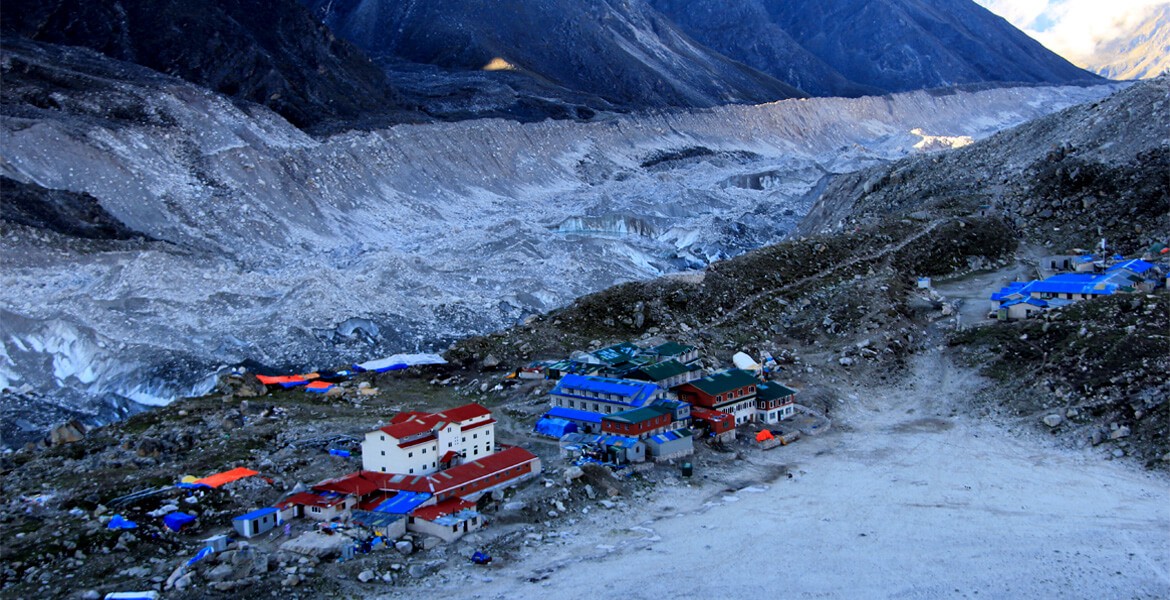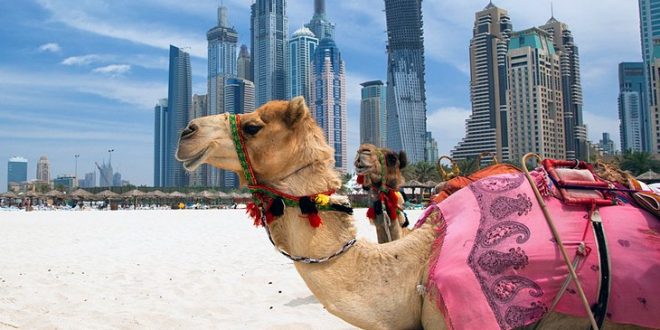The journey to Everest Base Camp is not only a physical one but also a cultural and spiritual insight into the lives of the Sherpa community and their strong connection to the mountains. Famed for their unparalleled mountaineering prowess, the Sherpas have always been the unsung heroes of high-altitude explorations, and their expertise ensures a rewarding and enriching trek to Everest Base Camp. They know the terrain, weather patterns, and the symptoms of altitude sickness better than anyone, and those skills make for the best kind of guide when you must undertake this arduous journey.
Everest Base Camp with Kala Patthar The trek takes place in the Khumbu region of Nepal, where Sherpa culture runs deep in the rugged mountain scenery. The Sherpas hold that the mountains are sacred, and their respect for nature is reflected in the prayer flags, stupas, and monasteries that dot the trekking route. The Everest Base Camp trek leads you through several Sherpa villages where you will experience their warm hospitality, close-knit community, and spiritual practices that have sustained them for generations. Trekkers get their first taste of the locals’ reverence for the mountains when they see Sherpas praying for safe passage through the mighty forces of nature.
Along the way, you’ll learn about the Sherpa way of life. One leaves Everest Base Camp not just with physical fatigue but with tales of folkloric stories of Yeti, Buddhist pilgrimage, and their values of family when they wake up each morning when they might do just anyone than while their family is asleep. The Sherpas feel a sense of land and are part of nature, and that is something that takes the experience of doing the trek to the next level, I reckon. The journey becomes more than just a trek to Everest Base Camp; it is an adventure threading through the tapestry of local culture, leaving an indelible mark in the hearts of trekkers long after they return home.
The Discovery of the Culture and Tradition of Sherpas
The Sherpa people are known for their love of heights and endurance, and this culture originated in the Himalayan mountains, which are mainly in the Khumbu Valley of Nepal. The Sherpas: Sherpas are an indigenous ethnic group that has lived in the high-altitude environment of the Himalayas for centuries and is known for their strength and endurance. Their culture is shaped by Tibetan Buddhism; most Sherpas are Buddhists who perform rituals celebrating the natural world, their ancestors, and spiritual deities. Family, community, and respect for the land are core values for Sherpas. Festivals such as Lhosar (Tibetan Everest Base Camp Trek Weather New Year) and the building of mani walls (stone walls inscribed with prayers, rituals not only some that accommodate them were widely followed by society) fluffy* The Sherpa people are also famed for their hospitality, treating trekkers, climbers, and visitors with warm welcomes in their homes and guesthouses. These traditions have been passed down through generations, and even with the increasing influence of modernization, the sherpas still have a deep connection to their culture, which is the core of their identity.
Trekking with a Nepali Sherpa | Everest base camp trek
The Everest Base Camp Trek would be impossible without the help of Sherpas. Sherpas were traditionally the guides, trusted companions, of climbers attempting to summit Mount Everest, owing to their intimate knowledge of the terrain coupled with their remarkable physical capability of sustaining the extreme conditions of the Himalayas. Buddha was appointed on credit, and today Sherpas remain a crucial aspect of the trekkers’ experience enabling them to guide and help along the trek to Everest Base Camp. They assist with spotting the less traveled, often more challenging ground, and help the trekkers avoid altitude sickness and any other issues. Sherpas also help with acclimatization, guiding trekkers through ways to adjust to the high altitudes in order to stave off altitude sickness. They are also invaluable for carrying all of our heavy gear, working out logistics on the ground, and sharing the local culture and history with us. The Sherpas provides trekkers with safe, fun, and culturally inflected experiences while crossing the Everest region. And their contribution is beyond the physical—it is about being caretakers of the environment and keepers of the region’s traditions.
Sherpa Traditions and Spirituality
The Sherpas are deeply spiritual people; Tibetan Buddhism is at the heart of their beliefs and practices. Many Sherpas believe their ancestors’ spirits dwell in the mountains, and that the mountains themselves are sacred beings. They follow rituals and ceremonies that pay tribute to deities, spirits, and natural phenomena, and this reverence for nature extends to every aspect of their daily lives. One of the most important rituals is praying to the mountain gods before setting off on any trek, ceremonies are held at local monasteries or in front of sacred stones. Sherpas likewise have faith in the idea of “Khata,” a ceremonial scarf gifted as a sign of goodwill and respect. Pilgrimages to hallowed grounds — including Tengboche Monastery and the many stupas along the Khumbu Valley — abound. And then again the old is linked anew, festivals like Lhosar (Tibetan New Year) celebrated with vivid ceremonies of offerings, food, prayer, and dance. Their relationship to their spirituality is central not only part of their daily lives but also to their interaction with trekkers and mountaineers, helping ground them (far more than a saying) with a reverent respect for the mountains and all who inhabit them.
What is Sherpa Hospitality?
Sherpa Hospitality is famous for its warmth and generosity. Savage, but welcoming, the Sherpa people are proud to help trekkers and climbers visit their villages home, providing a safe and comfortable refuge for a demanding trek to Everest Base Camp. Their hospitality is inherent because of their ancient values of kindness, respect, and community. When trekkers stay at the homes or guesthouses of the Sherpa, they are often treated to a cup of tea, some food, and a place to sleep, with a focus on making guests feel at home and part of the community. The Sherpas’ way is to give what they have, even when it’s little. Sherpa hospitality also includes help on the trail, with guides and porters there to assist or offer advice. This community spirit extends throughout the region, where Sherpas serve not merely as service providers but as genuine caretakers of the trekking experience. For many trekkers, this friendly hospitality is one of the most unforgettable parts of their travel in the Everest region. It expresses strong cultural values among the Sherpas, for whom caring for others — especially strangers — is considered a sacred duty.
Sherpa Language and Communication Guidelines
Everest Base Camp Short Trek Most Sherpas speak Sherpa, a Tibetan dialect; many also speak Nepali, which is the lingua franca of Nepal. While walking through the Everest region, many Sherpas, particularly guides and porters, know English due to their years of working with international trekkers and climbers. But knowing a couple of words or sayings in Sherpa or Nepali will add another dimension to your visit and help create rapport with your guide/host. Little things like commonly used phrases such as “Tashi Delek” (a traditional greeting meaning good luck) or “Dhanyabad” (thank you in Nepali) are always appreciated and can play a big role in honoring their culture. There may be some language barriers, but Sherpas are known for their patience and helpfulness. The guide also encourages you to keep a respectful attitude, use plain language, and consider non-verbal communication, with gestures or expressions. So, appreciating the sherpa culture, language, and system will definitely enhance your trekking experience and attach long-term emotional connectivity with these people.
History of Sherpan’s and their link to Mount Everest
Sherpas have a deep and rich history with Mount Everest, having called the Khumbu Valley home for centuries. They are thought to have arrived by migrating from Tibet around the 16th century, and their expertise in navigating the high-altitude landscape made them indispensable to explorers and mountaineers. Sherpas were first thrust into the international spotlight in the 1950s when they helped Western climbers in their efforts to reach the summit of Mount Everest. The best-known early Sherpa was Tenzing Norgay, who, together with Sir Edmund Hillary, became the first person to stand on the summit of Everest, in 1953. Today, Sherpas remain critical to mountaineering expeditions working as guides, porters, and support staff to climbers. It is their unique physical ability to survive in the extraordinary conditions of the highest of places, plus their local knowledge and cultural ties to the mountains that has secured the role of being the backbone of any Everest expedition. The connection the Sherpas have with Everest is not simply professional, but spiritual — many Sherpas consider the mountain sacred and believe it contains the spirits of their ancestors. That deep connection to the mountain highlights their work and cultural traditions; so the Sherpa people are truly a part of the Everest legacy.
Sherpa apparel and equipment
Sherpa’s garments are built to endure the tough and frigid conditions of the Himalayas. Their traditional dress is practical and has been used throughout centuries of living on mountains. The sherpas usually wear many layers of woolen and fleece clothes, thick jackets, and pants, to keep out the biting cold winds. The traditional costuming is crafted from local materials such as yak wool and hides, providing insulation and durability against the harsh weather of the high-altitude landscape.
Perhaps one of the most recognizable pieces of traditional Sherpa clothing is the chupa, a long, robe-like outer garment worn by both men and women. It is typically made of wool and is warm and comfy. Sherpas also wear long trek boots made of leather and felt, built to navigate rough grounds. They add warm hats, scarves, and gloves to shield against frostbite at higher altitudes.
Short Everest Base Camp Trek Sherpa backpacks are also a must-have piece of their equipment. These are purpose-built backpacks capable of carrying heavy loads—often exceeding 110 pounds—so Sherpas can transport goods back and forth to the base of Everest. The items are a testament to the Sherpas’ resilience and resourcefulness in adapting to their environment and making sure that they are well-prepared to face the rigors of the trek. Learning about and honoring their traditional clothing and gear gives a greater appreciation of the Sherpa’s intimate relationship with the mountains.
Sherpa Diet and Food Customs
The Sherpa people inhabit a high-altitude region, and their diet reflects the physically demanding lifestyle that comes with living in such an environment. The typical Sherpa diet is a very basic high-calorie food that gives them energy and keeps them going on long treks across the harshness of the Himalayas. Their diet consists of grains, vegetables, and dairy products, with rice, lentils, and barley being staple foods. These components are typically cooked as stews or soups, like dal bhat (lentil soup and rice), which is a staple individual dish at Sherpa homes. The delicious characteristics of these foods also provide important nutrients the physical work of Sherpas requires to keep their energy levels up.
Dairy products, particularly yak milk, are integral to the Sherpa diet; the milk is fashioned into cheese, yogurt, and butter. Another staple of Sherpa food is called Chhurpi (a kind of hard cheese), which can be transported easily and remains edible for a long time, which makes it handy for trekking. Butter tea, a combination of tea, butter, salt and occasionally milk, is another popular drink among Sherpas and provides warmth and a quick hit of energy.
Sherpas are known for their hospitality, offering trekkers tea, snacks, and hearty meals as they go. Not only is sharing food an important social practice but guests are treated with the same warmth and generosity as family.
Buddhism Plays an Important Role in Sherpa’s Life
Everest Base Camp Trek Highlights The Sherpa are deeply religious and Buddhism is a central part of their everyday life. For Sherpas, the mountains are sacred; their deep spiritual bond to the land is informed by Buddhist teachings. This is especially clear in the many monasteries, stupas, and prayer flags that dot the Everest region. In addition to determining the Sherpas’ connection with the natural environment, Buddhism offers away to deal with difficulties, to live in accordance with others, and to nurture inner calm.
A prominent outward expression of Buddhism within Sherpa culture is the mani stone; a large stone that is inscribed with sacred mantras. Sherpas frequently pause to pray at these stones, showing their allegiance and seeking a blessing for safe passage. Most Sherpa homes contain a Buddhist altar, which offers incense and other offerings daily. Rituals, most notably prayer and meditation, are a significant aspect of life, and Sherpas often ask monks for blessings before embarking on long treks.
That reverence for Buddhism carries over to the Everest Base Camp trek. It passes sacred sites, including the famous Tengboche Monastery, a center of spiritual activity where monks conduct rituals. They are part of a culture and spiritual existence that is centuries old, and understanding and respecting their significance helps to connect you to the land and its people; adding a substantive layer to the trek.
Sherpas Pitfalls in the Trekking Industry
Whether you simply want to trek to Everest base camp or are attempting to summit Everest, Sherpas are an essential part of the whole trekking industry, especially in the Everest region. However, Sherpas face many challenges, both on and off the mountain, despite their indispensable contributions. A chief challenge is the effect high altitude has on their bodies. Impact of medical conditions on porters: The high carrying weight (often above 50 kg) over wrongful geography leads to wear and tear of their muscles and joints, resulting in long-term health issues.
Everest Base Camp Trek Route Another pressing concern is the increased demand for trekking services, which is adding more strain on Sherpas. The days of tranquility at Everest Base Camp are long gone — too many people clogging up the trail and walking in masses on the same path bluntly multiplies the risks for those guiding them. Sherpas are exposed to deadly dangers like avalanches, altitude sickness, and extreme weather, making the work dangerous. The high-altitude environment can have dire health effects, like hypoxia and altitude sickness, from which sherpas are not immune.
And if the high-risk nature of their work doesn’t already warrant better pay, Sherpas are often underpaid as it is. For trekkers and mountaineers, the expeditions cost thousands of dollars, yet the Sherpas’ pay remains relatively low. This gap, along with a scarcity of healthcare services for those living upcountry, renders their livelihoods tenuous and challenging. There are ongoing efforts to enhance Sherpa’s working conditions, wages, and access to healthcare, but challenges persist.
Sherpa Communities as Environmental Custodians
Sherpa communities enjoy a strong relationship with their habitat, and tradition reflects a deep respect for nature. The custodians of the Everest region, Sherpas play a key part in protecting the area’s natural beauty and ecological balance. Environmental awareness has over the years become more of a priority within Sherpa life, especially because of the growing number of trekkers and mountaineers to have visited the Everest region.
Sherpas have historically been outspoken about sustainable trekking practices. Sherpa-led organizations and local communities emphasize the environmental impact of trekking, including waste reduction, wildlife protection, and ecosystem preservation in the Himalayas. Its treasure status has prompted discussions, especially about the environmental effects of hiking, such as promoting digestible products, bringing back garbage, and avoiding the coring of nature.
Sherpas have also spearheaded efforts to clean the Everest region. As tourists flocked to the area, the buildup of trash and leftover gear along the trekking paths and at Everest Base Camp became an issue. Annually, Sherpas run cleanup campaigns alongside organizations to pick up litter and preserve the beautiful mountains. The Sherpas deeply respect their land and have been making strides to keep its beauty intact for generations to come.
Trekking Tips: How to Respect Sherpa Culture
When trekking in the Everest region it is important to understand Sherpa culture. You are only about two-thirds of the way through your pilgrimage through their homeland, but to meet the Sherpa people, you will need to perceive them with gentle eyes and deeper appreciation because of their cultural and spiritual connection with the mystical land. familiarize yourself with local customs and traditions; this will make your journey more enriching and help you create great relationships with the Sherpa people.
Everest Base Camp Trek Permits Understanding the religious beliefs of the Sherpa culture is then one of the biggest things to respect. The Sherpas, who are followers of Tibetan Buddhism, worship sacred sites, including monasteries, prayer flags, and mani stones. It’s important to keep in mind local customs when passing these sites, including walking clockwise around religious structures and avoiding loud or disruptive behavior. Be sure to ask first before taking pictures, especially in a monastery or during prayers, since these are sacred activities.
Bt Sherpas also prize hospitality and community, so it’s best to interact with them respectfully. Be polite if greeted and accept food or tea if offered, as a positive sign. It’s a ritual to give them privacy, not to ask intrusive questions, but rather to ask about their culture in general through respectful conversation. Knowing their identity as guides and guardians of this land will enable you to better appreciate their vocation and cultivate a deeper connection on your hike.
Your respect for the Sherpas’ customs, beliefs, and lifestyle will go a long way in making your Himalayan trek a harmonious, mutually beneficial experience for you and the Sherpa people.





